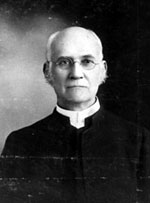- TOP
- About Kwansei Gakuin
- History and Educational Philosophy
- Participants in the Genesis of Kwansei Gakuin

Participants in the Genesis of Kwansei Gakuin
Newton, John Caldwell Calhoun (1848.5.25- 1931.11.10)
Dr. Newton could easily have spent his entire life in small-town South Carolina where he was born in 1848. He served as a soldier during the last year of the Civil War, in the Confederate army, when he was only 17 years old. This could have been an experience to sour his view of fellow Americans living in the northern states, but he became a model of intercultural understanding and the best Christian ideals.
After the war, J.C.C. Newton attended the Kentucky Military Institute, and was ordained as a minister in the Methodist Episcopal Church, South in 1874. Dr. Newton served several churches in Kentucky for ten years, and then went to Maryland, where he studied at Johns Hopkins University. There, he was a student of Professor Herbert Baxter Adams, who also taught both the famous Japanese thinker, NITOBE Inazo and Woodrow Wilson, later to become U.S. President.

After the war, J.C.C. Newton attended the Kentucky Military Institute, and was ordained as a minister in the Methodist Episcopal Church, South in 1874. Dr. Newton served several churches in Kentucky for ten years, and then went to Maryland, where he studied at Johns Hopkins University. There, he was a student of Professor Herbert Baxter Adams, who also taught both the famous Japanese thinker, NITOBE Inazo and Woodrow Wilson, later to become U.S. President.
One year after arriving in Japan, the Newtons moved from Tokyo to Kobe, where they joined the Lambuths and others to begin Kwansei Gakuin in 1889 with just a handful of students. Dr. Newton served as the dean of the Biblical School, a position which he held for many of the years he spent here. His deep faith and emphasis on scholarship established a firm foundation for Kwansei Gakuin and the department which would later become the School of Theology. Many of the early Methodist leaders of Japan were students of Dr. Newton.
Although poor health forced Dr. Newton and his wife to spend 1897 to 1904 back in the United States, they then returned to Kwansei Gakuin until 1923 when they were both 75 years old. In 1916, Dr. Newton reluctantly agreed to serve as president (incho) of Kwansei Gakuin after the long, capable leadership of Professor Yoshioka. His tenure as president was less than four years, but he worked hard to prepare for Kwansei Gakuin’s qualification as a university and to adapt to changing needs both inside and outside the school. He also supported the Canadian, Dr. C.J.L. Bates, who became his successor, and served for twenty years as president.
Throughout his career, Dr. Newton worked hard to bring understanding between his home country and his adopted country, Japan. He wrote books and articles introducing Japan to the English-speaking world. In Japan, his humility, quiet leadership, and sense of ethics were appreciated, not only by those in the Christian community, but by government officials and business leaders in Japan. Just before his death, a representative of the League of Nations visited Dr. Newton in Atlanta to ask advice on an international matter, demonstrating that his global perspective was respected very widely. -- [Ruth M. Grubel, "J. C. C. Newton, Christian Statesman," Chapel Shuho (Chapel Weekly), no. 6, 2007, p. 4.]
From left to right: W.R. Lambuth, Yoshikuni Yoshioka, Cornelius John Lighthall Bates, Kiichi Kanzaki

